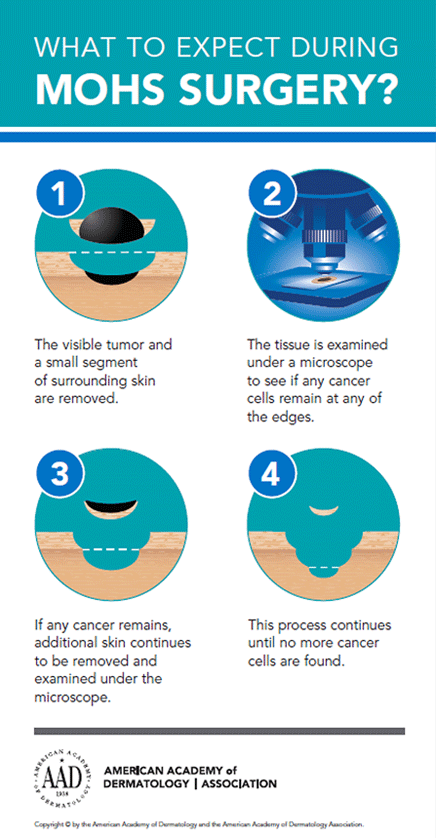Mohs Surgery is a highly specialized treatment for the total removal of skin cancer. Mohs Surgery is named in honor of Dr. Frederic Mohs, the physician who developed the technique. This method differs from all other treatments for skin cancer by allowing for microscopic examination of the complete tissue margin using detailed mapping techniques. This allows the surgeon to precisely remove the skin cancer, while preserving as much healthy tissue as possible.
Mohs surgeons are fellowship trained in the techniques of cancer removal, microscopic examination, and complex reconstructive techniques.
Detailed mapping techniques and complete microscopic examination of the tissue margins allow the Mohs surgeon to pinpoint areas of skin cancer that may be invisible to the naked eye. Therefore, even microscopic roots of cancer can be removed while removing as little normal tissue as possible. This accounts for the very high cure rate with Mohs surgery and allows the surgeon to keep the scar as small as possible.
When you arrive at the office, our staff will escort you into a surgical suite where your Mohs surgeon will anesthetize the area around the skin cancer with lidocaine, similar to what you had done for your skin biopsy. Once the area is fully numb, your Mohs surgeon will remove the visible cancer with the narrowest possible margin of normal skin. The removed tissue is carefully mapped and coded. The specimen is then brought to the adjacent laboratory where it is frozen and processed for microscopic examination.
The surgical excision takes only ten to fifteen minutes, however it takes approximately an hour to prepare and microscopically examine the slides. During this time you will have a temporary dressing and be able to wait comfortably in the waiting room. If skin cancer is found extending beyond the excised margins, you will be brought back to the surgical suite to remove another thin layer of tissue at the precise area of remaining skin cancer. Most skin cancers are removed in one or two stages, but there is no way to predict before surgery if the roots of the skin cancer will extend widely. Additional stages may be necessary. You may want to bring reading material to occupy your time while waiting.
Immediately after the skin cancer is removed, the decision is made to either allow the wound to heal naturally, or to repair the wound with stitches or a skin graft or flap. The decision is based on what will cause the least pain and leave the smallest scar based on the final size and depth of the wound.







